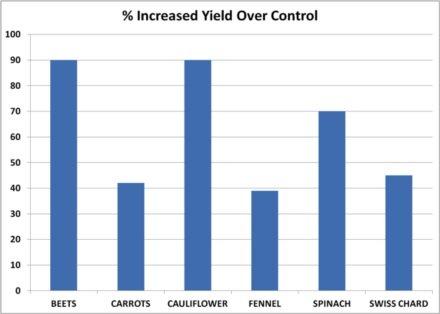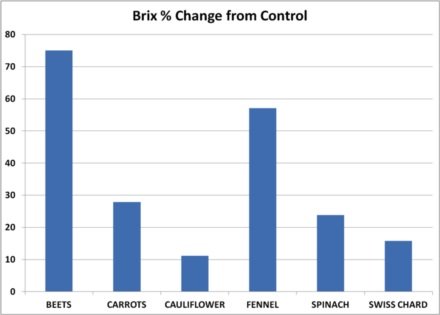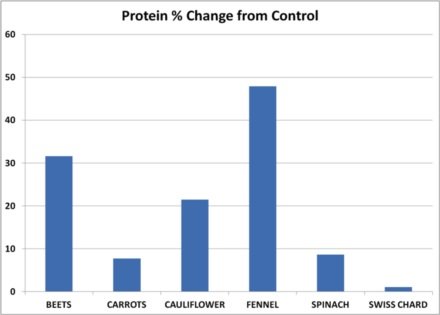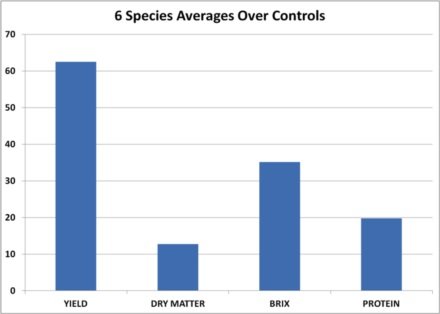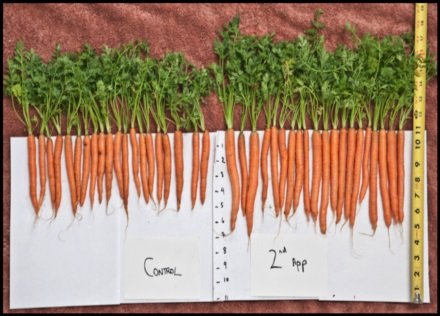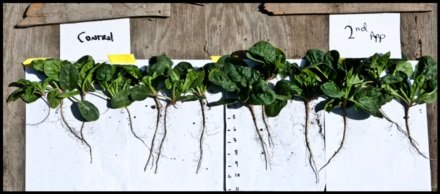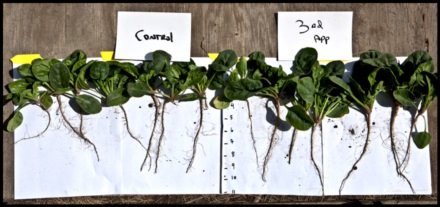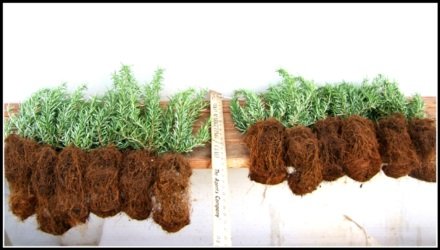Research
Field trials at the University of Louisiana in nematode infested soil
In 2007, a field trial, sponsored by Cal-Agri Products, was conducted by Dr. Edward Mc Gawley on corn at the University of Louisiana at Baton Rouge with the following results. Two test plots were treated at planting with a single application of Sea-Crop/Immutines One was treated with 18 liter per hectare and the other with 36 liter per hectare. Compared to an untreated control test plot the treated plots yielded increased corn harvests of 58.15% and 94.49%.
Cal-Agri Products had Dr. Mc Gawley conduct additional field trials at Louisiana State University at Baton Rouge in 2008. In this trial, Sea-Crop® was used as a root dip on plug transplants at the dilution rate of one part in fifty (2%). The treatment gave the following increases in marketable fruit shown in table 1. All of the tests at LSU took place in nematode infested soil that was inoculated with nematodes prior to or at planting.
Sea-Crop® and Immutines™ are one and the same product and are mentioned here as Sea-Crop/Immutines.
Field trials by Collé Agriculture 2012
County Line Farm 2012 Winter Trials
In the early part of 2012, Collé Agriculture performed testing at a commercial organic produce farm in Southern California. The testing documented the performance of Sea-Crop/Immutines under organic growing conditions.
One aim was to determine if yields increased when the only variable was the addition of Sea-Crop/Immutines Another goal was to determine if produce grown under commercial conditions and treated with Sea-Crop/Immutines contained a greater nutritional value.
The crops chosen for testing were baby beets, baby carrots, cauliflower, fennel, spinach and baby Swiss chard. These crops were grown in fields fertilized with hydrolyzed fish powder, chicken manure, and with both macro and micro mineral soil amendments.
A portion of each crop received treatment with Sea-Crop/Immutines in addition to the normal fertilization. In all, 3 applications were made, one soil drench and 2 foliar applications, totaling 38 liter per hectare. The larger, untreated, portion of each crop acted as the control.
As can be seen in table 2, yields were increased significantly. For cauliflower and spinach, total yields were used. For the rest, marketable yields, after culling for substandard produce, were used.
The next table of results, table 3, from the same trial shows comparative dry matter content. Dry matter represents everything in the sample other than water. Dry matter includes protein, fiber, fat, minerals, carbohydrates, etc.
Table 3 County Line Farm 2012 Winter Trials
Dry Matter % Change from Control
| Crop Planted | 3 applications % increase |
| Beets | +5.97 |
| Carrots | -0.95 |
| Cauliflower | +12.02 |
| Fennel | +2.82 |
| Spinach | +1.42 |
| Swiss Chard | +55.21 |
| Average for the 6 species | +12.72 |
Dry matter increases indicate enhanced flavor, better keeping quality and greater nutrient density
Degrees Brix is a measurement of the sugar content of an aqueous solution. During the trial Brix readings of the crops were taken with an optical device called a Brix refractometer. In addition to sugar content, the optical Brix readings include everything that is soluble in the liquid portion of the plant including vitamins, enzymes and hormones.
Table 4 shows that the treated crops had elevated Brix levels over the untreated controls. These results are a good confirmation of the dry matter readings in table 3 above.
As with dry matter content, Brix increases indicate enhanced flavor, better keeping quality and greater nutrient density. Next, table 5 shows that significant insect damage reduction was evident in the treated plots.
Table 5 County Line Farm 2012 Winter Trials
Insect Damage Reduction % Change from Control
| Crop Planted | 2 applications % Reduction | 3 applications % Reduction |
| Beets | 0.0 | 100.0 |
| Carrots | 33.3 | 33.3 |
| Cauliflower | 15.0 | 45.0 |
| Fennel | - | - |
| Spinach | - | - |
| Swiss Chard | 33.3 | 33.3 |
| Average for the 4 species | 20.4 | 52.9 |
There was no measurable insect damage in the Fennel or Spinach crops.
The results clearly show that in each category: yield, dry matter, Brix, and insect damage reduction, there is a cumulative benefit with additional applications.
Table 6, shows that protein content increases when plants are treated with Sea-Crop/Immutines
In a world hungry for protein these are very significant increases. The average protein increase for the 6 species was 19.73%.
All of these third party testing results show that Sea-Crop/Immutines is able to perform at least as well as Dr. Murray’s sea solids did, or better. This illustrates that the bioactive principles contained in seawater can be greatly concentrated for more economical shipment and ease of application. In many cases, nitrogen and other inputs may be reduced while maintaining the same or even increased levels of crop production. Depending on the soil and the crop it may be possible to reduce chemical fertilizer inputs, such as nitrogen, thus providing significant savings and improvement in soil microflora populations. Case study of a popcorn farming in Indiana by John Kempf of Advancing Eco-Agriculture illustrates this:
Table 8
| Year | Nitrogen per acre | % reduction | State average yield | This farm’s yield | % better |
| 1 | 71 kg | 0 | 816 kg | 1134 kg | 39 |
| 2 | 52,6 kg | 26.5 | 1315 kg | 1814 kg | 38 |
| 3 | 50,2 kg | 30 | 1361 kg | 2268 kg | 67 |
County Line Farm 2012 Winter Trials
Photograph 1 shows a comparison between carrots planted in the same field on the same day. The carrots on the right received 3 applications of Sea-Crop/Immutines, one soil drench at planting followed by 2 foliar applications.
Baby Carrot Test Detail:
- Seed date - 10/19/2011
- Soil drench application date – 10/20/2011, 19 liter per hectare Sea-Crop/Immutines at 5% strength co-applied with 19 liter molasses per hectare at 5% strength.
- Emergence - 10/26/2011
- 1st foliar app date - 11/16/2011, 9,5 liter per hectare Sea-Crop/Immutines at 2% strength.
- 2nd foliar app date - 12/7/2011, 9,5 liter per hectare Sea-Crop/Immutinesat 2% strength.
- Harvest date - 2/13/2012, Duration of growing cycle -118 days
- Marketable Yield % increase 41.57%
- Brix Refracto meter reading increase 30%
- Insect Damage % decrease 33%
Photograph 2 compares spinach after the spinach shown on the right received 2 applications of Sea-Crop. Photograph 3 below compares the untreated control to treated spinach after it had received 3 applications of Sea-Crop/Immutines
Table 9 - Spinach Test % Increase Over Control
| Catagory | 2 applications Sea-Crop/Immutines | 3 applications Sea-Crop/Immutines |
| Brix (average of 4 plots) | +28.6% | +23.8% |
| Fresh Weight (greens portion) 35 representative plants of each category | +43% | +70.1% |
| Dry Matter Content Increase | +11.8% | + 5.9% |
Rosemary (Salem) starts were transplanted into one gallon pots and treated with Sea-Crop/Immutines at the rate of 30 liters per hectare. Cotton seed meal was used on both the untreated control and treated tests as an organic fertilizer. After 30 days the plants were dug up, the roots washed and the entire plant desiccated so that dry matter weights could be compared. The percentage gain of the Sea-Crop/Immutines Streated plants as compared to the controls is listed below.
Table 10
| Start Date | 7-19-07 |
| Duration | 45 days |
| Replications | 6 |
| *Dry Matter Increase Roots | 23.14% |
| *Dry Matter Increase Tops | 15.29% |
| *Dry Matter Increase Total | 17.24% |
*Dry Matter Increase of Sea-Crop/Immutines Treated Plants

